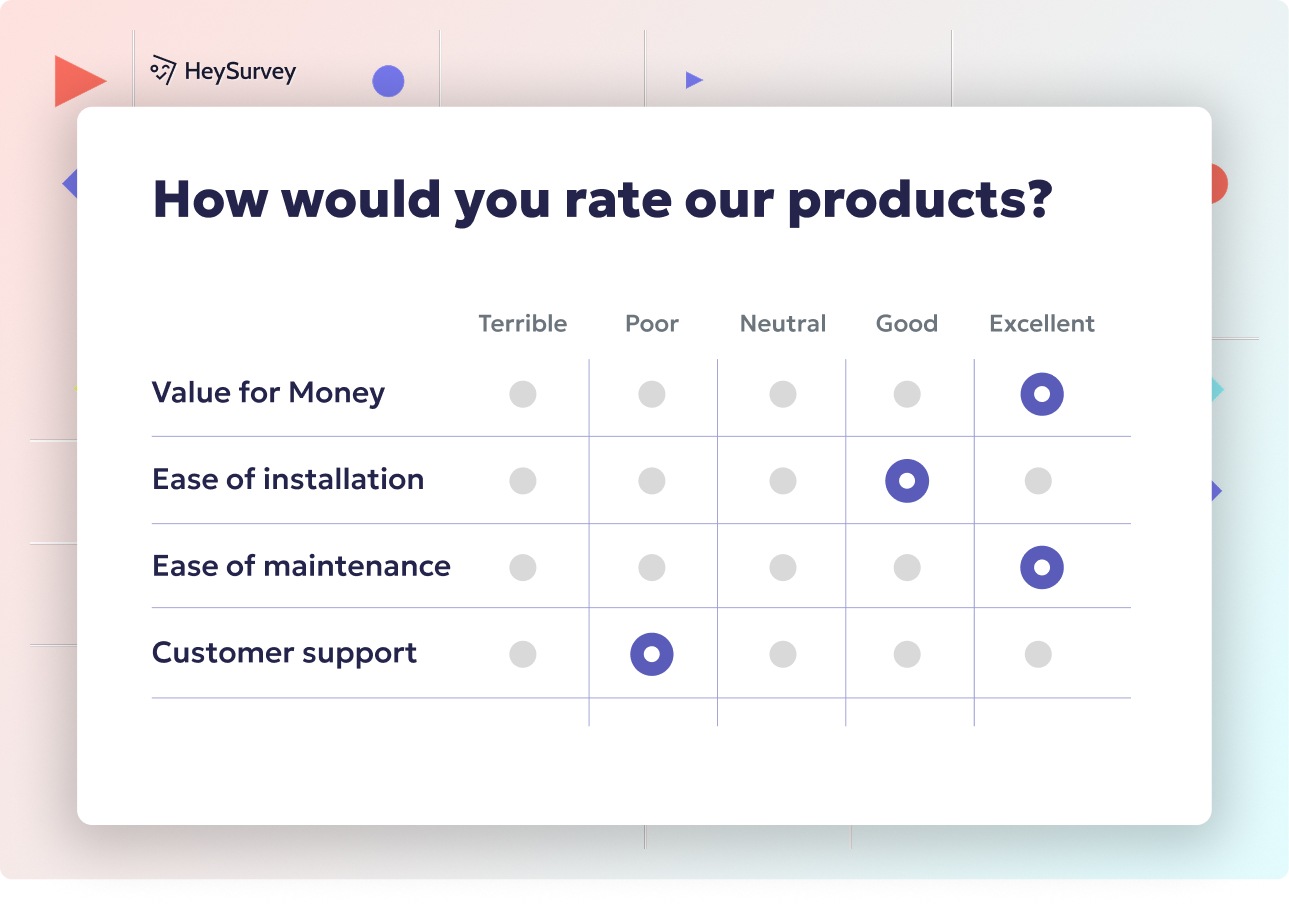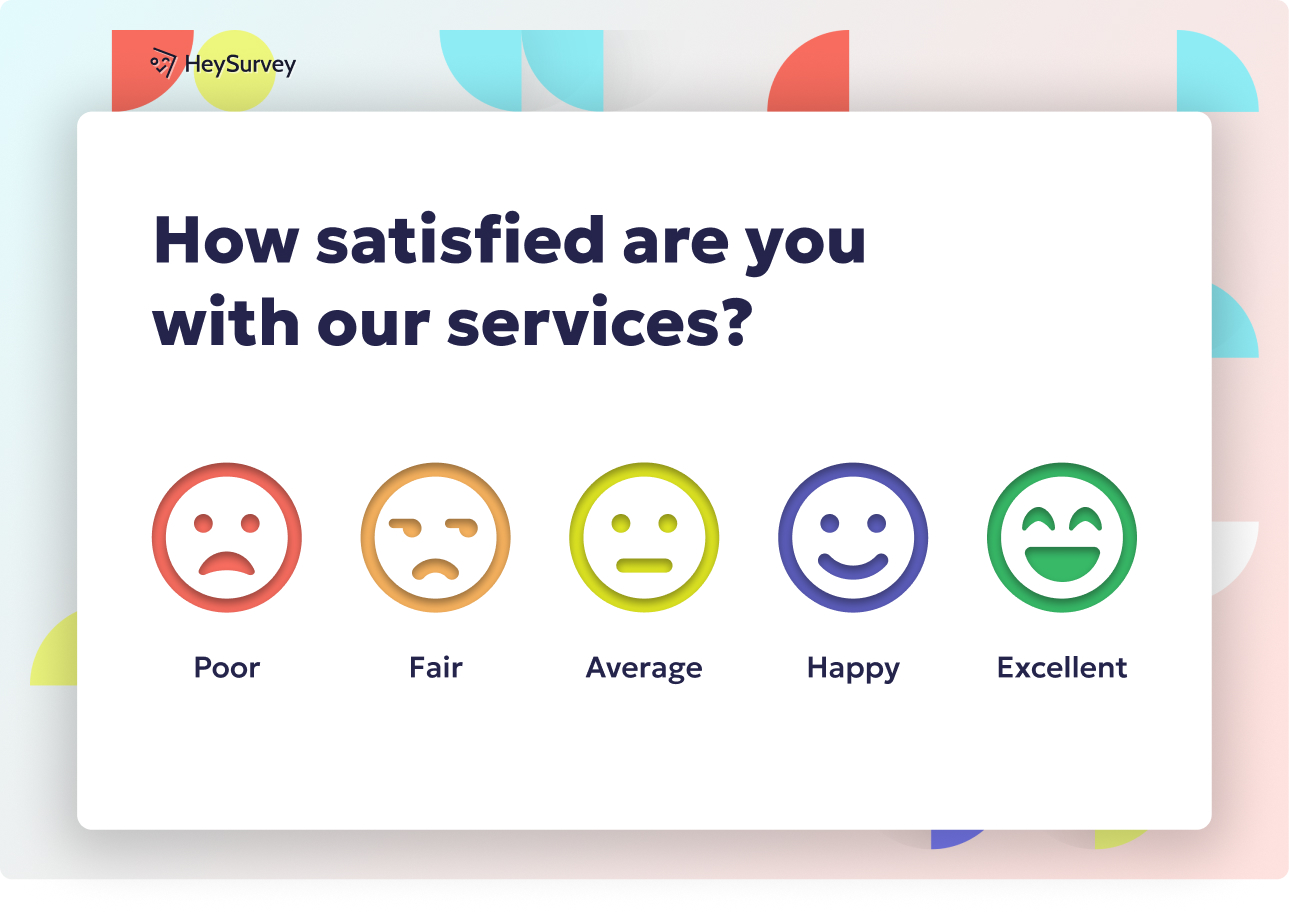32 Survey Teacher Evaluation Questions for Effective Feedback
Discover 25+ survey teacher evaluation questions with sample items and expert tips for effective teacher feedback surveys in education settings.
Every great classroom thrives on feedback loops. Teacher evaluation survey questions drive improvement, boost teacher morale, and reveal hidden gems (and stumbling blocks!) in instruction. Educators, schools, and districts use these surveys during mid-semester, at the end-of-term, or as part of accreditation reviews to collect meaningful data. If you want to know how to evaluate a teacher or craft effective teacher feedback forms, you’ll discover actionable tips, sample survey items, and the best practices here for designing any teacher performance survey that actually sparks growth.
End-of-Course Student Feedback Survey
Why & When to Use This Survey
The end-of-semester teacher survey holds a special place in any school’s toolkit. It collects students’ collective wisdom after a whirlwind term, giving a reflective snapshot of overall course effectiveness. When students complete these forms during the final week, their opinions influence future course design and power annual teacher performance reviews.
You’ll want this survey when: - The semester wraps up, and it’s time to reflect. - Teachers and schools crave holistic feedback for future planning. - There’s a need to document professional growth for personnel files and teacher evaluations.
Making the most of this survey depends on timing and anonymity. Students are more candid at the end, knowing there’s no impact on their grades. For administrators, it’s a treasure trove to inform teaching assignments, curriculum improvements, and mentorship opportunities. Final course evaluation questions also give teachers a fuller view of what resonated and what fizzled out—which means more tailored lessons next time.
Sample Questions
How clearly did the teacher explain course objectives at the start of the term?
Rate the effectiveness of the teacher’s feedback on your assignments.
How often did the teacher create an inclusive classroom environment?
What teaching method worked best for you in this course?
How well did the teacher address your questions or concerns during the semester?
How organized was the course content and pacing?
Overall, how satisfied are you with the teacher’s performance?
For teachers, these end-of-course insights guide professional reflection and self-improvement. For school leaders, they illuminate trends across classes and departments.
Research indicates that while student surveys can provide valuable insights into teaching practices, they often fail to predict student learning outcomes, suggesting their limited effectiveness in evaluating teacher performance. (educationnext.org)

Creating a teacher evaluation survey with HeySurvey is surprisingly simple. Just follow these 3 easy steps to get your survey up and running, then explore bonus tips to make it shine!
Step 1: Create a New Survey
- Head to HeySurvey and click Create New Survey.
- Choose either Start from an empty sheet for total customization, or pick a pre-built template tailored for teacher evaluations.
- Give your survey a name (something like "End-of-Course Teacher Feedback") to keep things organized.
- Once done, you’ll land in the Survey Editor, ready to add your questions.
Step 2: Add Questions
- Click the Add Question button at the top or between existing questions.
- Pick the question type that fits your needs—Choices, Scale, Text, etc.
- Type in your teacher evaluation survey questions, like “How clearly did the teacher explain course objectives?”
- Mark important questions as required to ensure responses.
- Duplicate questions to save time or add images to spice things up.
Step 3: Publish Your Survey
- When your questions feel just right, hit Preview to see how it looks from a respondent’s view.
- Tweak design and wording if needed using the Designer Sidebar (colors, fonts, animations, layouts—your survey, your style).
- Once satisfied, click Publish to get a shareable link.
- To collect and analyze responses, sign up for a HeySurvey account (it’s free to start).
Bonus Step 1: Apply Branding
- Upload your school or district logo to personalize the survey header.
- Customize colors, fonts, and background images to reflect your school spirit.
- This helps build trust with respondents and adds some visual flair.
Bonus Step 2: Define Settings
- Set start and end dates to control when your survey’s live.
- Limit the number of responses if you want to cap feedback.
- Add a redirect URL to thank respondents or direct them somewhere else after completing the survey.
- Enable options like allowing respondents to view results for transparency.
Bonus Step 3: Use Branching for Smarter Surveys
- Tailor question paths based on answers—for example, skip questions that don’t apply or dive deeper after certain responses.
- This keeps surveys short, focused, and respectful of respondents’ time.
- Define multiple endings with custom messages to leave a positive impression.
When you’re ready, hit the button below to jump straight into a teacher evaluation template and start customizing!
Mid-Semester Formative Feedback Survey
Why & When to Use This Survey
A midterm teacher feedback form is like a compass check: it helps teachers gauge what’s working before the journey ends. This real-time diagnostic tool, typically given halfway through the term, creates space for authentic, on-the-fly teaching pivots. Think of it as a teacher’s secret weapon for maximizing student learning while there’s still plenty of runway.
Perfect moments to use this survey include: - The midpoint of a semester or term, before major projects and tests land. - After a tricky unit when feedback could prevent recurring misunderstandings. - Any time there’s a need to address bushels of student questions or flagging motivation.
With formative midterm surveys, students get to help co-pilot their learning experience. Teachers find out if their explanations are resonating or if their pacing feels like a wild rollercoaster. Best of all, the immediate feedback means students reap the benefits before final grades are etched in stone.
Sample Questions
Which classroom activities help you learn most effectively so far?
What could the teacher start doing to improve your understanding?
Does the current homework load feel manageable?
How comfortable are you asking this teacher for help?
What’s one thing the teacher should stop doing in the second half of the course?
How clear are the teacher’s instructions for assignments?
What one change would most improve the second half of the course?
Honest, timely feedback lets teachers adjust, giving everyone new wind in their sails. For students, it’s empowering! Their voices shape instruction, making the classroom a collaborative venture.
Research indicates that mid-semester feedback surveys, particularly those incorporating open-ended questions, significantly enhance teaching effectiveness and student engagement. (odu.edu)
Peer Observation Feedback Survey
Why & When to Use This Survey
Peer review of teaching is a collegial ritual—think Iron Chef, but for lesson plans. A teacher observation survey empowers colleagues to learn from each other’s strengths and offer constructive pointers in a safe, non-evaluative environment. Conducted during scheduled peer-observation windows or lesson-study cycles, this survey is a powerful professional development mechanism with none of the test anxiety.
Key reasons and timings for peer feedback include: - Supporting new or early-career teachers with practical advice. - Encouraging professional dialogue and reflective practice among teaching teams. - Spotting fresh instructional ideas or troubleshooting classroom challenges collaboratively.
This isn’t a gotcha moment. Instead, teachers get actionable feedback from folks who understand the daily grind. Observers bring a bird’s-eye view—a new lens—that cuts through the classroom routine. Peer review of teaching isn’t just about critique, it’s about celebrating innovation and sharing tricks of the trade.
Sample Questions
How effectively did the teacher check for student understanding?
Describe the level of student engagement you observed.
Were lesson objectives and outcomes clearly communicated?
What instructional strategy was most effective during the lesson?
How well did the teacher manage classroom transitions and timing?
Did the teacher adjust teaching when students seemed confused?
Recommend one actionable improvement for future lessons.
Collegial, candid, and constructive—these surveys turn every classroom visit into a learning opportunity for both the observer and the observed.
Teacher Self-Reflection Survey
Why & When to Use This Survey
Grab your favorite mug and get introspective! The teacher self-evaluation survey is a moment for teachers to step back and analyze their own practice. Whether completed after a big unit, following assessments, or during a professional-development session, these reflections are sparks for growth and innovation.
Ideal moments to use this tool: - Wrapping up a tricky unit or project that challenged the status quo. - Post-assessment, when reflecting on what worked (and what didn’t). - When setting professional goals or after teacher-training workshops.
Self-reflection checklist for teachers prompts deep thinking about both strengths and growth edges. These surveys transform hindsight into wisdom, nudging teachers to experiment with new strategies, revisit classroom management, and take pride in what’s going well.
Sample Questions
Which part of your lesson plan exceeded expectations?
Where did students struggle the most, and why?
What evidence shows your instructional goals were met?
Which classroom-management technique needs refinement?
How did you adapt for different learning needs or paces?
What feedback from students surprised you, and how did you respond?
Identify one new strategy you will implement next term.
For teachers, honest self-reflection nourishes professional growth. For schools, these surveys foster a culture of continuous improvement and risk-taking.
Systematic reflection on teaching experiences significantly enhances student teachers' self-efficacy for reflection, fostering professional growth and instructional improvement. (link.springer.com)
Parent/Guardian Feedback Survey
Why & When to Use This Survey
Family-school partnerships bloom with communication. The parent survey for teacher evaluation is a bridge between home and classroom, illuminating how families experience school through their child’s eyes. Typically administered each semester or clustered around parent–teacher conferences, these surveys empower families and make everyone feel heard.
Perfect moments to use this survey: - When report cards go out, opening a two-way feedback channel. - During or after parent–teacher conferences. - Annually, to collect broad insights about communication and support.
Families want to know their voices matter. Guardian feedback forms gather priceless info about communication styles, support needs, and classroom safety. Teachers learn what’s working (and what’s not) outside of class hours, often revealing unseen strengths or hidden blind spots.
Sample Questions
How well does the teacher communicate your child’s academic progress?
Rate the teacher’s responsiveness to your questions or concerns.
Does the teacher foster a safe and respectful classroom environment?
How effectively does the teacher motivate your child to learn?
How frequently does the teacher provide updates on classroom events or homework?
Does the teacher collaborate well with support staff or specialists?
What additional support could the teacher provide your child?
When families share their perspectives, classrooms become more welcoming and responsive. This two-way mirror helps teachers, administrators, and parents co-create positive learning environments.
360-Degree Feedback Survey
Why & When to Use This Survey
The comprehensive teacher evaluation survey is the Swiss Army knife of feedback, gathering insights from students, colleagues, administrators, and teachers themselves. Often reserved for annual reviews, tenure applications, or professional growth plans, this multi-source tool paints a 360-degree portrait that goes way beyond test scores.
The best moments to launch this survey? - During annual review cycles for holistic development. - When considering teachers for promotion, leadership, or tenure. - Biannually for professional growth, mentoring, or accreditation reviews.
Multi-source feedback questions create a panoramic view of teaching strengths, teamwork, community contributions, and innovation. It’s not just about fixing problems—it’s about finding superpowers that one source alone might miss.
Sample Questions
How consistently does the teacher align lessons with curriculum standards?
Assess the teacher’s collaboration with colleagues.
How effectively does the teacher integrate technology into instruction?
Rate the teacher’s contribution to the school community.
How well does the teacher support diverse learners?
How open is the teacher to constructive feedback and coaching?
Identify the teacher’s strongest professional asset.
When feedback comes from every angle, growth feels more achievable—and teachers see their impact both up close and far beyond their own classroom walls.
Exit Survey for Graduating Students
Why & When to Use This Survey
There’s no insight quite like that of students preparing to toss their caps in the air. The graduate exit survey lets departing students reflect on all their schooling years, highlighting the teachers who shaped their journey for the better (and a few lessons learned the hard way).
Best times for this survey: - In the weeks before graduation festivities. - When students transfer out, ensuring the school gathers feedback from all experiences. - As part of alumni programs, collecting long-term reflections on teaching quality.
Alumni teacher feedback shines a light on trends across teachers and departments. It identifies patterns, flags instructional gaps, and uncovers legendary teaching qualities that future educators can emulate or adapt.
Sample Questions
Which teacher had the greatest positive impact on your learning journey?
What teaching qualities consistently helped you succeed?
Describe any instructional gaps you noticed across your courses.
How prepared do you feel for the next educational step?
What professional behaviors should all teachers at our school adopt?
Is there one teaching moment you’ll never forget, and why?
How can our school better support future student cohorts?
Graduates’ voices are powerful guideposts for school improvement, curriculum design, and teacher mentorship initiatives.
Best Practices: Dos & Don’ts for Crafting Teacher Evaluation Survey Questions
Crafting a teacher performance survey that gets honest, productive answers is both art and science. The best surveys are focused, friendly, and give everyone a fair shot at sharing their truth. Here are a few go-to rules that separate surveys that sparkle from those that flop:
Do:
- Align every question with measurable competencies like clarity, engagement, or subject mastery.
- Use neutral, behavior-based language to reduce bias and boost fairness.
- Keep surveys concise—aim for 10–20 well-chosen items for higher response rates.
- Pilot-test survey drafts with a small group to weed out confusing or ambiguous items.
- Emphasize data privacy, reminding participants their answers are anonymous and confidential.
Don’t: - Avoid double-barreled questions that combine two ideas into one—“How engaging and organized was the teacher?” is a recipe for confusion. - Don’t use jargon or technical language that would baffle students or parents. - Never forget to analyze and act on results—a survey in a drawer helps no one.
Surveys are most valuable when tailored to your unique school culture. Use these sample questions as a jumping-off point, and remember: clear feedback leads to clearer classrooms! Close the feedback loop by sharing results with your team and students, and celebrate all positive changes that grow from these candid conversations.
With thoughtful teacher evaluation survey questions, everyone wins—the teacher, the student, and the entire school community.
Related Teacher Survey Surveys

32 Teacher Perception Survey Questions for School Improvement
Explore 30 insightful teacher perception survey questions, covering school climate, PD needs, lea...

29 Survey Questions for Teachers to Boost Success
Explore 25+ insightful survey questions for teachers to boost engagement, professional growth, an...

32 Teacher Survey Questions: Types, Examples & Tips
Discover 45+ teacher survey questions with examples and tips to improve job satisfaction, PD, res...

